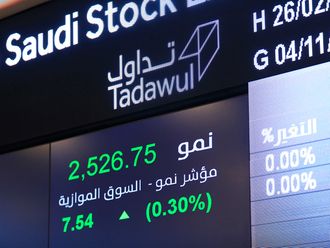
London: Gold, in the 11th year of its longest winning streak in at least nine decades, is poised to enter a bear market, according to Dennis Gartman, who correctly predicted the slump in commodities in 2008.
The metal, which traded at $1,663.22 an ounce in London, may decline to as low as $1,475, the economist wrote Monday in his Suffolk, Virginia-based Gartman Letter. He sold the last of his gold on Monday. Bullion has already dropped 13 per cent from the record $1,921.15 reached September 6 and $1,475 would extend that to more than 20 per cent, the common definition of a bear market.
"Since the early autumn here in the Northern Hemisphere gold has failed to make a new high," Gartman wrote.
"Each high has been progressively lower than the previous high, and now we've confirmation that the new interim low is lower than the previous low. We have the beginnings of a real bear market, and the death of a bull."
The metal typically moves inversely to the dollar, which yesterday reached a two-month high against the euro after Fitch Ratings and Moody's Investors Service said on Monday that a European Union summit last week offered little help in ending the region's debt crisis. Bullion is still 17 per cent higher this year and holdings in gold-backed exchange-traded products are at a record, a hoard now valued at $126.3 billion.
Gold's performance this year compares with a 1.3 per cent advance in the Standard & Poor's GSCI gauge of 24 commodities, in which it is the third-best performer behind gasoil and cattle. The MSCI All-Country World Index of equities retreated 10 per cent and Treasuries returned 9.2 per cent, a Bank of America Corp. index shows.
Contracts outstanding
The slump in equities spurred some investors to sell their gold to cover losses. Open interest, or contracts outstanding, in gold futures traded on the Comex exchange in New York, fell to 427,756 contracts, from 546,601 in July, bourse data show. "So much damage has been done to the psychology of the market in the past week and so many late longs have been caught off guard that we think wholesale liquidation, and perhaps forced liquidation, shall be the outcome," Gartman wrote.
ETP investors are increasingly bullish. Holdings in the products climbed 3.8 metric tonnes to an all-time high of 2,360.5 tonnes on Monday, according to data compiled by Bloomberg. That's equal to more than 10 months of global mine supply and greater than the reserves of all but four of the world's central banks, which are expanding holdings for the first time in a generation.
Hedge funds and other money managers boosted bets on higher futures prices for the first time in three weeks. Net-long positions in gold futures and options rose by 3.5 per cent to 151,347 contracts in the week ended December 6, US Commodity Futures Trading Commission data show. That's still down 40 per cent since the beginning of August, when positions were at the highest level since at least June 2006, the data show.
In China, the second-largest consumer, gold imports to the mainland from Hong Kong surged 51 per cent to 86.3 tonnes in October to a monthly record, according to the Census and Statistics Department of the Hong Kong government. China imported more than 300 tonnes for all of 2010, Yi Gang, People's Bank of China Vice Governor, said in February.
"Buying of that sort should have sent gold prices soaring," Gartman wrote. "One of the oldest rules of trading is simply this: a market that cannot or does not respond to bullish news is a bearish market not a bullish one."
The S&P GSCI Index of 24 commodities plunged as much as 66 per cent in the seven months through February 2009 after Gartman in June 2008 said there would be a "tidal wave" of selling. The economist said on August 23 that gold was entering the stage when prices go "parabolic", two weeks before the metal peaked at its record high.











